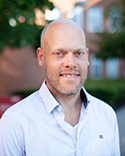Section of forensic imaging and osteology
The Section for Forensic Imaging and Osteology conducts research within advanced diagnostic imaging with particular focus on trauma and conditions that affect the bone tissue.
The section has facilities for whole body CT scanning, contrast pumps for angiography, digital x-ray, a hard tissue laboratory, equipment for histomorphometry and a laboratory for anthropological analyses.
The section’s expertise and facilities provide the basis for a large network of interdisciplinary and cross-sectorial collaboration, and we also offer certain services in the field of CT scanning and hard tissue preparation. Please contact Lene Warner Thorup Boel for more information.
CT scanning
The objective of research with the help of CT scanning is partly to utilise the possibility of looking into an intact body, and partly to extract information and data that cannot be obtained by other means. This information and data can help identify mechanisms relating to injuries and damage, as well as disease correlations. This generates knowledge that can ultimately benefit patients in terms of prevention of injuries and diseases, as well as treatment.
CT scans of the deceased contribute to new knowledge about trauma mechanisms, for example by mapping the types of fracture in different traumas. CT scans of the deceased can demonstrate air in the body in cases where this is not expected, and thereby contribute with new knowledge about causes of death and their mechanisms.
CT angiography
CT scans of the deceased following the addition of contrast agents in the blood vessels contribute with knowledge about e.g. sources of bleeding. By altering the composition and viscosity of the contrast agent, along with the pressure and volume when pumping into the body, it is possible to attain different preparations of the vascular system. By adding contrast agents in selected locations, it is possible to target the visualisation of vessels and sources of bleeding (partial angiography).
We will examine whether further development of the method can contribute to visualisation of capillaries and microfractures, which may not be recognised by traditional diagnostic imaging methods.
BMD measurements
Bone Mineral Density (BMD) can be calculated on the basis of CT scans, when this is undertaken with a dedicated phantom. It is thereby possible to investigate whether different factors are associated with an effect on BMD. We are currently investigating whether mental illness as a result of lifestyle or medication alters BMD. The investigation is part of the national Survive project (PDF in Danish).
Osteology
Osteology is the scientific study of bones. Research is being conducted on both a macroscopic and microscopic level using different techniques such as X-ray and CT scans, as well as microscopy and histomorphometry of undecalcified, plastic-embedded bone tissue or other hard tissue. The research contributes with knowledge about changes to the bone tissue in relation to age, disease and the influence of factors such as medicine and alcohol.
The hard tissue laboratory
At the hard tissue laboratory we excel in a technique where bone tissue is embedded in plastic while undecalcified and subsequently cut and stained for the purpose of microscopy and histomorphometry. The method is used for studying the sacroiliac joints and the cervical facet joints. The method has also been used for the investigation of Grauballe Man’s bones.
NewCast
The Department of Forensic Medicine has onsite facilities for stereological analysis. The laboratory contains a complete set-up based on NewCast software (Visiopharm), which makes advanced design-based analysis possible.
Anthropological laboratory
The laboratory has forensic anthropological expertise and is able to assess bone material for the purpose of police investigations. After agreement it is also possible to examine older bone material for detailed description of e.g. trauma, disease development and congenital disorders. There is also an ongoing project relating to growth disorders. In some cases it can be relevant to involve the department’s forensic dentists in an assessment or a project.
Diagnostic imaging research group PIMAS
Paraclinical Imaging Studies Group
We are a group of researchers from AU and AUH with a common interest in visualising traumas and the musculoskeletal. The studies are not performed on living patients, but rather on post mortem material and animal models, hence the term paraclinical research. We use a wide range of different diagnostic imaging methods with the objective of developing new diagnostic imaging methods that can be used for clinical diagnosis and treatment of musculoskeletal disorders and trauma.
Road traffic accidents
Injury Pattern Analysis and lesion pathology
Explaining the different lesions that occur in connection with a given accident is based on detailed examination and analysis. The more precisely the indication of the manner and cause of death can be formulated, the better the position of citizens in terms of legal rights, and the better we are equipped to provide prophylactic advice. Injury Pattern Analysis a tool within the medico-legal field, where, among other things, experienced knowledge (pattern recognition, empiricism) is combined with the available scientific evidence regarding causality, lesion pathology etc. For such analyses, the focus is on the application of advanced imaging techniques (post mortem computer tomography, virtopsy method etc.) to document and visualise/present the lesions identified. Microscopy is used in case-based practice to support the other information collected. In its work the department focuses on the concept of causal connection, including e.g. the relevance of the trauma, the temporal correlation and the observed lesions.
Knowledge dissemination and teaching
The department staff contribute to both the academic and public environment through publications, editorials, lectures and participation in consultations concerning road safety conditions. The department’s teaching also includes the field of traffic medicine. The department strives to ensure that knowledge dissemination takes place in an accessible and relevant manner.


